Contents
When growing garlic, gardeners face various problems: either it does not grow, or for no reason, the feathers begin to turn yellow. Pulling the garlic out of the ground, you can see small worms or rot on the bottom. How to deal with such problems, by what means to get rid of adversity.
Very often, vegetable growers do not want to resort to special fertilizers, they want to grow organic products. Experienced farmers have long been using pharmacy products in their gardens. Feeding garlic with ammonia is one of the options for saving plants and the possibility of obtaining large heads with many cloves. The article will discuss the role of ammonia as a fertilizer and a life-saving agent from pests.
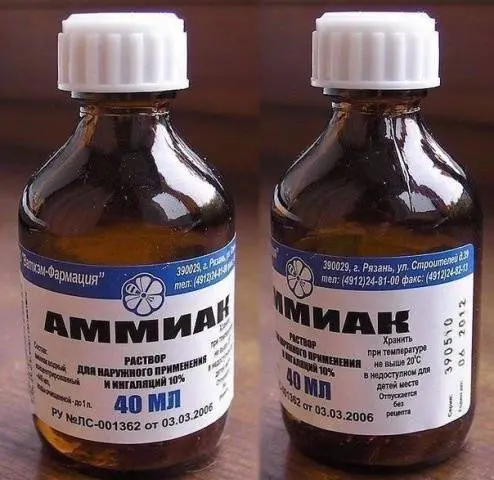
What you need to know about ammonia
Ammonia is a gas that cannot be seen, but can be easily identified by smell. Ammonia, ammonia are the names of the same chemical preparation containing ammonia. Medicines are sold in pharmacies without a prescription. The main use is to bring a person to life when fainting.
Can you tell me what does the garlic and vegetable garden have to do with it? After all, plants do not need to be taken out of a swoon. Yes, this is true, but plants need ammonia like air. Ammonia is an excellent nitrogen-containing fertilizer. The substance contains a large amount of nitrogen, it is necessary for the formation of chlorophyll in the green mass of plants. Despite the fact that this element is present in the air in large quantities, plants cannot absorb it, they need nitrogen contained in the soil.
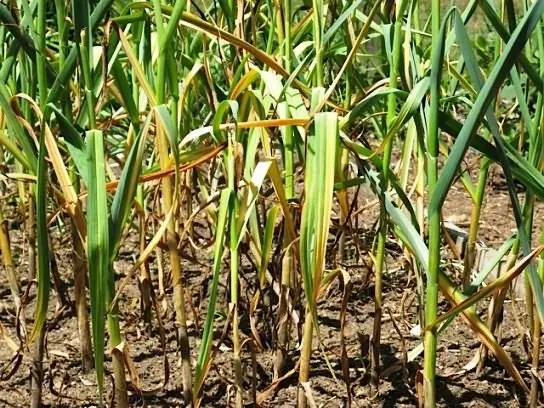
The role of nitrogen for plants
Agronomists call nitrogen the bread for plants. When using nitrogen-containing fertilizers, nitrates accumulate in plants. With regards to fertilizing with ammonia, there are a lot of positive points:
- First of all, plants do not have ammonia depots, therefore, they cannot accumulate nitrogen obtained from ammonia.
- Secondly, the use of ammonia is much more economical. Today, fertilizers are very expensive.
- Thirdly, the nitrogen received by plants during feeding activates the growth of the green mass of garlic, it becomes saturated, bright green.
- Fourth, there is no risk of overfeeding garlic with ammonia.
You should not wait until the feathers begin to turn pale and yellow, that is, signal that the garlic lacks nitrogen. Timely top dressing of the plant will help to avoid trouble. In addition, getting into the soil, ammonia improves the structure of the soil, normalizes its acidity.
Planting and care
Garlic, like any cultivated plant, needs to be fed. In order for the plant to develop normally, you need to start feeding from the moment of planting. There are a number of fertilizers that are used to feed garlic during vegetative development. They should not be neglected.
After the bed is prepared, it must be watered with a solution of ammonia to enrich the soil with easily digestible nitrogen. To do this, prepare a composition of 10 liters of water and 50 ml of ammonia. Planted cloves will not only receive top dressing, but also protection from pests.
When the first two feather leaves appear, one more top dressing is carried out. Two tablespoons of ammonia are added to a ten-liter bucket of cold water. This will be foliar top dressing.
The next top dressing can be carried out every 10 days with a less concentrated solution. Even if the plant does not give a signal, prevention never hurts. After watering and fertilizing, the soil in the garden with garlic needs to be loosened.
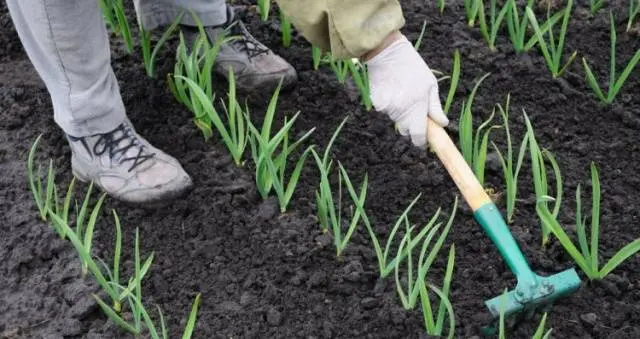
When else garlic needs ammonia
How do you know that garlic needs to be fertilized with ammonia? The plant itself will “tell” about it.
The tips of the feathers, regardless of the fact that the plants are constantly watered, turn yellow, the greens fade. This is the very first distress signal. The plant needs urgent help. You can provide it with the help of foliar top dressing of garlic. For this, a solution is prepared in a ten-liter watering can with the addition of 60 ml of ammonia. It is desirable to spray the garlic in the evening, after watering the ground with clean water.
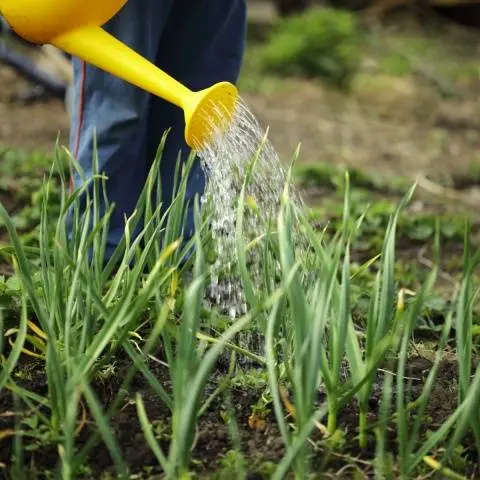
Pests can cause yellowing of garlic feathers. So ammonia not only compensates for the lack of nitrogen, but is also able to scare away harmful insects with its specific smell:
- onion fly and carrot fly. She lays her eggs in garlic too;
- aphids capable of sucking juice from green mass;
- a wireworm that eats passages in the tender pulp of cloves;
- secretive trunk or weevil, it can destroy the green feathers of garlic by eating moves in it.
Timely basal and foliar feeding with ammonia will save garlic from these pests. For this, a weak solution of ammonia is prepared – 25 ml per 10 liters of water. So that the solution does not immediately stack on the ground, dissolve laundry soap.
How to prepare a soap solution:
- Soap is crushed with a grater and poured into hot water.
- When the soap solution has cooled a little, it is gradually poured into water, with constant stirring. You need to stir until the gray flakes disappear. Iridescent bubbles should form on the surface of the water.
- After that, ammonia is poured in.
Water and simultaneously feed the garlic with ammonia once a week or every 10 days during the entire growing season. Only in this case can the crop be saved.
Ammonia for garlic and onions:
Safety Precautions
Ammonia does not accumulate in the heads of garlic, that is, grown products are safe for humans. But when working with him you need to be careful, follow the safety rules.
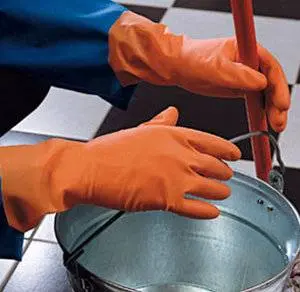
Let’s look at this issue in more detail:
- If the gardener has hypertension, then he is forbidden to work with ammonia. Corrosive fumes can provoke its sharp increase.
- Do not add anything to the ammonia solution.
- Root or foliar top dressing of garlic with ammonia should be carried out in calm weather.
- If ammonia gets on the skin or eyes when preparing the solution, rinse quickly with plenty of clean water. If the burning sensation does not stop, you should seek medical help.
- When fertilizing garlic with ammonia, gloves and a mask must be used.
To store ammonia, you need to choose a place where children and animals cannot reach. The fact is that a sharp breath of ammonia can cause reflex respiratory arrest. If, through negligence, ammonia enters the mouth, then it causes a severe burn.
To summarize
So, the competent use of ammonia in a personal plot or cottage helps to solve a twofold problem: it is used as a universal fertilizer to obtain a rich harvest, and protects plantings from harmful insects.
The reason for the love of gardeners for ammonia is harmlessness to plants and humans. After all, nitrogen does not accumulate either in garlic, or in onions, or in other fruits after feeding with ammonia. The same cannot be said for many nitrogenous fertilizers.
Experienced vegetable growers can determine by the condition of the plant whether the next dressing is necessary for garlic. Beginners don’t always succeed. Overfeeding with nitrogen can cause growth retardation. Therefore, we advise you to feed garlic no more than once every 10 days with a not too concentrated solution.









